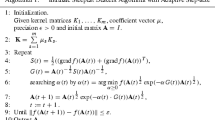Abstract
The usefulness of metric learning in image classification has been proven and has attracted increasing attention in recent research. In conventional metric learning, it is assumed that the source and target instances are distributed identically, however, real-world problems may not have such an assumption. Therefore, for better classifying, we need abundant labeled images, which are inaccessible due to the high cost of labeling. In this way, the knowledge transfer could be utilized. In this paper, we present a metric transfer learning approach entitled as “Metric Transfer Learning via Geometric Knowledge Embedding (MTL-GKE)” to actuate metric learning in transfer learning. Specifically, we learn two projection matrices for each domain to project the source and target domains to a new feature space. In the new shared sub-space, Mahalanobis distance metric is learned to maximize inter-class and minimize intra-class distances in target domain, while a novel instance reweighting scheme based on the graph optimization is applied, simultaneously, to employ the weights of source samples for distribution matching. The results of different experiments on several datasets on object and handwriting recognition tasks indicate the effectiveness of the proposed MTL-GKE compared to other state-of-the-arts methods.



Similar content being viewed by others
References
L’heureux A, Grolinger K, Elyamany HF, Capretz MAM (2017) Machine learning with big data: Challenges and approaches. IEEE Access 5:7776–7797
Pan SJ, Yang Q (2009) A survey on transfer learning. IEEE Trans Knowl Data Eng 22 (10):1345–1359
Weiss K, Khoshgoftaar TM, Wang D (2016) A survey of transfer learning. J Big Data 3 (1):9
Xu Y, Pan SJ, Xiong H, Wu Q, Luo R, Min H, Song H (2017) A unified framework for metric transfer learning. IEEE Trans Knowl Data Eng 29(6):1158–1171
Chattopadhyay R, Sun Q, Fan W, Davidson I, Panchanathan S, Ye J (2012) Multisource domain adaptation and its application to early detection of fatigue. ACM Trans Knowl Discov Data (TKDD) 6(4):18
Huang J, Gretton A, Borgwardt K, Schölkopf B, Smola AJ (2007) Correcting sample selection bias by unlabeled data. In: Advances in neural information processing systems, pp 601–608
Jiang J, Zhai C (2007) Instance weighting for domain adaptation in nlp. In: Proceedings of the 45th annual meeting of the association of computational linguistics, pp 264–271
Yi Y, Doretto G (2010) Boosting for transfer learning with multiple sources. In: IEEE Computer Society Conference on Computer Vision and Pattern Recognition. IEEE 2010, pp 1855–1862
Margolis A (2011) A literature review of domain adaptation with unlabeled data. Technical Report, pp 1–42
Pan SJ, Tsang IW, Kwok JT, Yang Q (2010) Domain adaptation via transfer component analysis. IEEE Trans Neural Netw 22(2):199–210
Yu Z, Yeung D-Y (2010) Transfer metric learning by learning task relationships. In: Proceedings of the 16th ACM SIGKDD international conference on Knowledge discovery and data mining. . ACM, pp 1199–1208
Hu J, Lu J, Tan Y-P (2015) Deep transfer metric learning. In: Proceedings of the IEEE conference on computer vision and pattern recognition, pp 325–333
Nguyen B, De Baets B (2019) Kernel-based distance metric learning for supervised k-means clustering. IEEE transactions on neural networks and learning systems
Tahmoresnezhad J, Hashemi S (2016) An efficient yet effective random partitioning and feature weighting approach for transfer learning. Int J Pattern Recogn Artif Intell 30(02):1651003
Tahmoresnezhad J, Hashemi S (2015) Common feature extraction in multi-source domains for transfer learning. In: 2015 7th Conference on Information and Knowledge Technology (IKT). IEEE, pp 1–5
Hal Daumé III (2009) Frustratingly easy domain adaptation. arXiv:0907.1815
Duan L, Tsang IW, Xu D (2012) Domain transfer multiple kernel learning. IEEE Trans Pattern Anal Mach Intell 34(3):465– 479
Long M, Wang J, Ding G, Sun J, Yu PS (2013) Transfer feature learning with joint distribution adaptation. In: Proceedings of the IEEE international conference on computer vision, pp 2200–2207
Cao B, Ni X, Sun J-T, Wang G, Yang Q (2011) Distance metric learning under covariate shift. In: Twenty-Second International Joint Conference on Artificial Intelligence
Shimodaira H (2000) Improving predictive inference under covariate shift by weighting the log-likelihood function. J Stat Plann Inference 90(2):227–244
Tahmoresnezhad J, Hashemi S (2017) Visual domain adaptation via transfer feature learning. Knowl Inf Syst 50(2):585– 605
Sugiyama M, Nakajima S, Kashima H, Buenau PV, Kawanabe M (2008) Direct importance estimation with model selection and its application to covariate shift adaptation. In: Advances in neural information processing systems, pp 1433–1440
Li J, Lu K, Zi H, Zhu L, Shen HT (2018) Transfer independently together: a generalized framework for domain adaptation. IEEE Trans Cybern 49(6):2144–2155
De Maesschalck R, Jouan-Rimbaud D, Massart DL (2000) The mahalanobis distance. Chem Intel Labor Syst 50(1):1–18
Soleimani A, Araabi BN, Fouladi K (2016) Deep multitask metric learning for offline signature verification. Pattern Recogn Lett 80:84–90
Chen Y, Wang N, Zhang Z (2018) Darkrank: Accelerating deep metric learning via cross sample similarities transfer. In: Thirty-Second AAAI Conference on Artificial Intelligence
Ding Z, Fu Y (2016) Robust transfer metric learning for image classification. IEEE Trans Image Process 26(2):660–670
Yu J, Wang M, Tao D (2012) Semisupervised multiview distance metric learning for cartoon synthesis. IEEE Trans Image Process 21(11):4636–4648
Zhu Y, Chen Y, Lu Z, Pan SJ, Xue G-R, Yu Y, Yang Q (2011) Heterogeneous transfer learning for image classification. In: Twenty-Fifth AAAI Conference on Artificial Intelligence
Singh AP, Gordon GJ (2008) Relational learning via collective matrix factorization. In: Proceedings of the 14th ACM SIGKDD international conference on Knowledge discovery and data mining. ACM, pp 650–658
Gong B, Shi Y, Sha F, Grauman K (2012) Geodesic flow kernel for unsupervised domain adaptation. In IEEE Conference on Computer Vision and Pattern Recognition. IEEE 2012, pp 2066–2073
Wang W, Wang H, Zhang C, Xu F (2015) Transfer feature representation via multiple kernel learning. In: Proceedings of the Twenty-Ninth AAAI Conference on Artificial Intelligence. AAAI Press, pp 3073–3079
Smola A, Gretton A, Song L, Schölkopf B (2007) A hilbert space embedding for distributions. In International Conference on Algorithmic Learning Theory. Springer, pp 13–31
Xu P, Deng Z, Wang J, Zhang Q, Choi K-S, Wang S (2019) Transfer representation learning with tsk fuzzy system. IEEE Transactions on Fuzzy Systems
Wang L-X (1999) Analysis and design of hierarchical fuzzy systems. IEEE Trans Fuzzy Syst 7 (5):617–624
Long M, Cao Y, Cao Z, Wang J, Jordan MI (2018) Transferable representation learning with deep adaptation networks. IEEE Trans Pattern Anal Mach Intell 41(12):3071–3085
Rossiello G, Gliozzo A, Glass M (2019) Learning to transfer relational representations through analogy. In: proceedings of the AAAI Conference on Artificial Intelligence, vol 33, pp 10015–10016
Gong B, Grauman K, Sha F (2013) Connecting the dots with landmarks Discriminatively learning domain-invariant features for unsupervised domain adaptation. In: International Conference on Machine Learning, pp 222–230
Aljundi R, Emonet R, Muselet D, Sebban M (2015) Landmarks-based kernelized subspace alignment for unsupervised domain adaptation. In: Proceedings of the IEEE Conference on Computer Vision and Pattern Recognition, pp 56–63
Wang J, Lu H, Plataniotis KN, Lu J (2009) Gaussian kernel optimization for pattern classification. Pattern Recogn 42(7):1237–1247
Hershey JR, Olsen PA (2007) Approximating the kullback leibler divergence between gaussian mixture models. In: IEEE International Conference on Acoustics, Speech and Signal processing-ICASSP’07, vol 4. IEEE 2007, pp IV–317
Gretton A, Borgwardt KM, Rasch M, Schölkopf B, Smola AJ (2007) A kernel approach to comparing distributions. In: Proceedings of the National Conference on Artificial Intelligence, vol 22, pp 1637. AAAI Press; MIT Press, Menlo Park
Holland SM (2008) Principal components analysis (pca). Department of Geology, University of Georgia, Athens, pp 30602–2501
Yan S, Xu D, Zhang B, Zhang H-J, Yang Q, Lin S (2006) Graph embedding and extensions: A general framework for dimensionality reduction. IEEE Trans Pattern Anal Mach Intell 29(1):40–51
Guattery S, Miller GL (2000) Graph embeddings and laplacian eigenvalues. SIAM J Matrix Anal Appl 21(3):703–723
Tsai Y-HH, Yeh Y-R, Wang Y-CF (2016) Learning cross-domain landmarks for heterogeneous domain adaptation. In: Proceedings of the IEEE conference on computer vision and pattern recognition, pp 5081–5090
Liao X, Ya X, Lawrence Carin. (2005) Logistic regression with an auxiliary data source. In: Proceedings of the 22nd international conference on Machine learning. ACM, pp 505–512
Weinberger KQ, Tesauro G (2007) Metric learning for kernel regression. In: Artificial Intelligence and Statistics, pp 612–619
Griffin G, Holub A, Perona P (2007) Caltech-256 object category dataset. California Institute of Technology
Hull JJ (1994) A database for handwritten text recognition research. IEEE Trans Pattern Anal Mach Intell 16(5):550–554
LeCun Y, Bottou L, Bengio Y, Haffner P et al (1998) Gradient-based learning applied to document recognitio. Proc IEEE 86(11):2278–2324
Turk M, Pentland A (1991) Eigenfaces for recognition. J Cogn Neurosci 3(1):71–86
Wang H, Wang W, Zhang C, Xu F (2014) Cross-domain metric learning based on information theory. In: Twenty-Eighth AAAI Conference on Artificial Intelligence
Davis JV, Kulis B, Jain P, Sra S, Dhillon IS (2007) Information-theoretic metric learning. In: Proceedings of the 24th international conference on Machine learnin. ACM, pp 209–216
Lu K, Kou Y, Zhang D (2017) Learning domain-invariant subspace using domain features and independence maximization. IEEE Trans Cybern 48(1):288–299
Sanodiya RKx, Mathew J (2019) A framework for semi-supervised metric transfer learning on manifolds. Knowl-Based Syst 176:1–14
Sanodiya RK, Mathew J, Saha S, Thalakottur MD (2019) A new transfer learning algorithm in semi-supervised setting. IEEE Access 7:42956–42967
Mahadevan S, Mishra B, Ghosh S (2018) A unified framework for domain adaptation using metric learning on manifolds. In Joint European Conference on Machine Learning and Knowledge Discovery in Databases. Springer, pp 843–860
Chen M, Xu Z, Weinberger K, Sha F (2012) Marginalized denoising autoencoders for domain adaptation. arXiv:1206.468
Hoffman J, Rodner E, Donahue J, Darrell T, Saenko K (2013) Efficient learning of domain-invariant image representation. arXiv:1301.3224
Author information
Authors and Affiliations
Corresponding author
Additional information
Publisher’s note
Springer Nature remains neutral with regard to jurisdictional claims in published maps and institutional affiliations.
Rights and permissions
About this article
Cite this article
Ahmadvand, M., Tahmoresnezhad, J. Metric transfer learning via geometric knowledge embedding. Appl Intell 51, 921–934 (2021). https://doi.org/10.1007/s10489-020-01853-7
Published:
Issue Date:
DOI: https://doi.org/10.1007/s10489-020-01853-7




